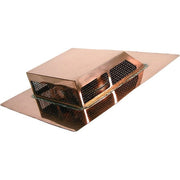Attic Vents
Does your attic need to be vented?
Yes. Proper attic ventilation is more than just an architectural detail—it's a critical component of home maintenance that protects your property from potential damage and enhances overall energy efficiency. Think of attic vents as the lungs of your home, allowing it to breathe and regulate internal conditions.
Our attic vents promote proper airflow, helping to regulate temperature and moisture. They're built from durable materials to ensure lasting performance.
Remember, attic vents are not just accessories—they're essential protective elements that safeguard your home's structural integrity and your family's comfort.
Types of attic vents
When it comes to vents for attics, homeowners have several essential options:
- Soffit Vents: These vents are installed along the eaves of your roof, allowing cool air to enter the attic from the lowest point. Typically made of aluminum or vinyl, soffit vents create a critical intake point for airflow, working in tandem with other ventilation systems.
- Gable Vents: Positioned on the side walls of the attic, gable vents facilitate cross-ventilation by allowing hot air to escape. They're particularly effective in homes with complex roof designs and can be both functional and decorative.
- Ridge Vents: Installed along the peak of the roof, ridge vents are perhaps the most sophisticated attic roof vent option. They run the entire length of the roofline, creating a continuous exhaust point that allows warm, moist air to escape naturally.
How to properly vent an attic
Effective attic ventilation follows a simple but crucial principle: balance between intake and exhaust. Here's a breakdown of the process:
- Assess Current Ventilation: Determine your existing ventilation system's effectiveness by checking for signs of moisture, heat buildup, or uneven temperature distribution.
- Calculate Ventilation Needs: The general rule is 1 square foot of ventilation for every 300 square feet of attic space, with a 50/50 split between intake and exhaust vents.
- Choose Complementary Vent Types: Combine soffit vents (intake) with ridge or gable vents (exhaust) to create a comprehensive airflow system.
- Professional Installation: While some homeowners might attempt DIY installation, professional assessment ensures optimal placement and performance.
How much does attic ventilation cost?
Investing in proper attic ventilation is a crucial home improvement decision. Our attic vent solutions range from $487 to $698, depending on:
- Home size
- Roof complexity
- Number and type of vents required
- Installation complexity







